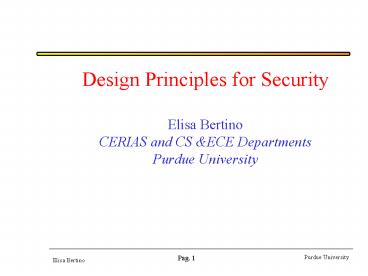Pag' 1 - PowerPoint PPT Presentation
1 / 13
Title:
Pag' 1
Description:
Inhibit communication an entity can communicate with other entities only when ... user knows the root password; (ii) the user is in the wheel group (with GID 0) ... – PowerPoint PPT presentation
Number of Views:28
Avg rating:3.0/5.0
Title: Pag' 1
1
Design Principles for SecurityElisa
BertinoCERIAS and CS ECE DepartmentsPurdue
University
2
Topics (Chapter 12 of Textbook)
- Overview
- Principles
- Least Privilege
- Fail-Safe Defaults
- Economy of Mechanism
- Complete Mediation
- Open Design
- Separation of Privilege
- Least Common Mechanism
- Psychological Acceptability
3
Overview
- Saltzer and Schroeder 1975 defined the 8
principles that are based on the ideas of
simplicity and restriction - Simplicity
- Less to go wrong
- Fewer possible inconsistencies
- Easy to understand
- Restriction
- Minimize access an entity can access only
information it needs (also known as need to
know principle) - Inhibit communication an entity can communicate
with other entities only when necessary, and in
few (and narrow) ways as possible
4
Least Privilege
- The principle of least privilege states that an
entity should be given only those privileges that
it needs in order to complete its task - The function of an entity, and not its identity,
should control the assignment of rights - Rights should be added as needed, discarded after
use
5
Fail-Safe Defaults
- The principle of fail-safe defaults state that,
unless an entity is given explicit access to an
object, it should be denied access to that object - This principle requires that the default access
permission to an object be none
6
Economy of Mechanism
- The principle of economy of mechanism states that
security mechanisms should be as simple as
possible - Simpler means less can go wrong
- And when errors occur, they are easier to
understand and fix - Interfaces and interactions
- Interfaces to other modules are crucial, because
modules often make implicit assumptions about
input or output parameters or the current system
state
7
Complete Mediation
- The principle of complete mediation requires that
all accesses to objects be checked to ensure that
they are allowed - Usually done once, on first action
- UNIX access checked on open, not checked
thereafter - If permissions change after, may get unauthorized
access - This approach violates the principle of complete
mediation
8
Open Design
- The principle of open design states that the
security of a mechanism should not depend on
secrecy of its design or implementation - If the strength of a programs security depends
on the ignorance of user, a knowledgeable user
can defeat the security mechanism - Security through obscurity is not a good
principle - This principles does not apply to information
such as passwords or cryptographic keys (these
are data and not algorithms)
9
Open Design
- Issues of proprietary software and trade secrets
complicate the application of this principle - In some cases companies do not want their designs
made public to protect them from competitors - The principle then requires that the design and
implementation be available to people barred from
disclosing it outside the company
10
Separation of Privilege
- The principle of separation of privileges states
that a system should not grant permission based
on a single condition. - In other words more than one condition must be
verified in order to gain access - Separation of duty
- Example company check for more than 75,000 must
be signed by two officers of the company - Example On Berkely-based versions of Unix, a
user is not allowed to change from his accounts
to the root account unless two conditions are
verified (i) the user knows the root password
(ii) the user is in the wheel group (with GID 0)
11
Least Common Mechanism
- The principle of least common mechanism states
that mechanisms used to access resources should
not be shared - Information can flow along shared channels
- Covert channels
- Isolation
- Virtual machines
- Sandboxes
12
Psychological Acceptability
- The principle of psychological acceptability
states that security mechanisms should not make
the resource more difficult to access than if the
security mechanisms were not present - Hide complexity introduced by security mechanisms
- Ease of installation, configuration, use
- Human factors critical here
- On the other hand, security requires that the
messages impart no unnecessary information - For example, if a user supplies the wrong
password, the system should reject the attempt
with a message saying that the login failed. If
it were to say that the password was incorrect,
the user would know that the account name was
legitimate
13
Key Points
- Principles of secure design underlie all
security-related mechanisms - They encompass not only technical details but
also human interaction - Require
- Good understanding of goal of mechanism and
environment in which it is to be used - Careful analysis and design
- Careful implementation























![[PDF] DOWNLOAD Notebook:: Black Cover - Size (8.5 x 11 inches) 120 Pag PowerPoint PPT Presentation](https://s3.amazonaws.com/images.powershow.com/10096140.th0.jpg?_=20240811127)


![Read [PDF] Phase 10 Score Sheets: Phase 10 card game 110 pag PowerPoint PPT Presentation](https://s3.amazonaws.com/images.powershow.com/10107876.th0.jpg?_=20240825021)




